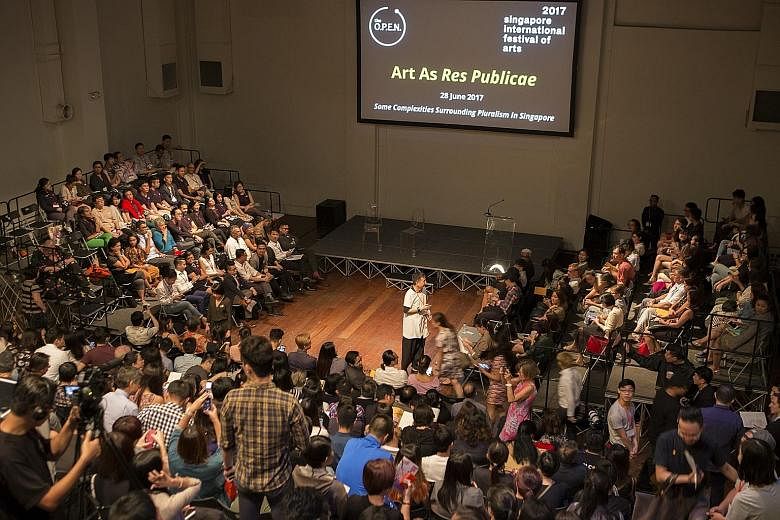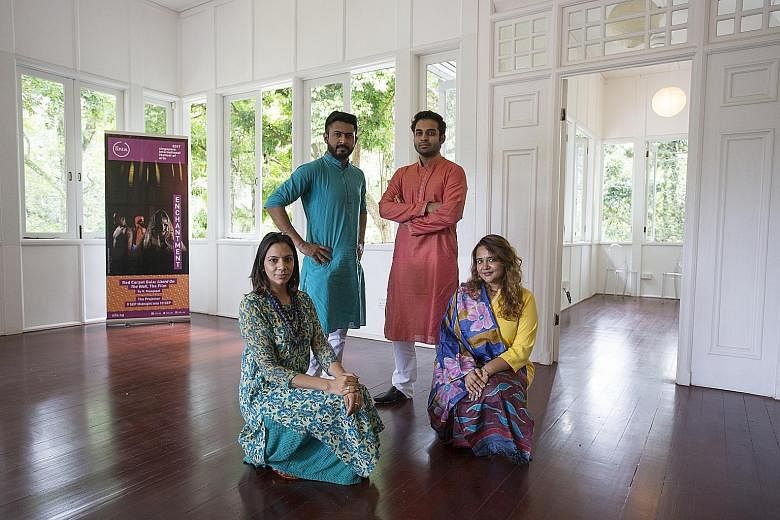REVIEW / THEATRE
ART AS RES PUBLICAE
The O.PE.N. 72-13/Last Wednesday
LIZARD ON THE WALL
K. Rajagopal /The O.P.E.N.
Secret location/Last Friday
Two participatory arts events last week deliberately put the audience in the spotlight and the results were eye-opening.
Instead of watching a scripted and staged performance, people witnessed the theatre of public opinion as more than 40 discussants debated hot-button issues in Art As Res Publicae.
About 400 turned up for a discussion on pluralism last Wednesday. A day later, 300 came for a debate on the future of eldercare in an ageing Singapore.
Separately, last Friday and over the weekend, dozens of ticket-holders were extras on the set of director K. Rajagopal's Lizard On The Wall.
They were taken to a secret filming location, costumed, made up and made to act or dance as guests during a traditional Punjabi wedding. The scenes may appear on screen when the film is shown in September, during the Singapore International Festival of Arts (Sifa).
Both events were part of The O.P.E.N., a pre-festival programme held annually since 2014 to engage audiences before the main season of performances.
Education and entertainment are not easy to balance, but festival director Ong Keng Sen and O.P.E.N. director Noorlinah Mohamed walk the tightrope this year. They aim to enchant audiences and also deepen viewers' connections to and understanding of the arts.
A public debate can do all this and be the highlight of an arts festival. The Singapore Writers Festival often closes with a spirited discussion on comically provocative topics. In December last year, the theme This House Believes That Singaporeans Are In The Mood For Love had more than 600 people crowding Victoria Theatre.
Over two nights, Art As Res Publicae explored the need for the arts to express different, even controversial, ideas.
Last Wednesday began with a reading of a scene from Eleanor Wong's 1995 play Wills & Secession.
It illustrated a conservative woman's hesitation in accepting her sister's lesbian partner. Commentators such as interfaith activist Imran Taib weighed in on the subject. Later, the discussants considered whether or not to allow artistic works to express statements such as "Religious people are ignorant and delusional" and "I would love to see these gays die for their cause".
Despite the fiery topics, the discussion was tame, in part because the organisers' attempts to bring in known conservative voices were unsuccessful. As arts educator T. Sasitharan said, there was no elephant in the room. He called for the authorities to allow more spaces for differences to flourish and differing voices to have their say.
Art As Res Publicae was no dramatic spectacle, but it made audiences think about the deliberations that should occur before ratings and advisories are issued to theatre and film.
It also fostered electric conversations in smaller, private groups during the dinner break. A large and public discussion mechanism of this sort is rare in Singapore. People are unused to openly expressing dissenting or unpopular opinion. Perhaps the experiment of Art As Res Publicae should be repeated in public spaces such as schools and community centres until Singaporeans become more used to the rules of rational debate and the art of tolerant compromise.
Lizard On The Wall was another learning experience, offering many a glimpse into the customs of a minority community in Singapore. It also opened many eyes to the gritty realities of film-making.
Extras were made to feel like VIPs with costume changes, make-overs and personalised attention from the director.
It was still exhausting work that made one appreciate the dedication of career film-makers. It is impossible to understand the reality of doing take after take until one is smiling, singing and dancing repeatedly in a hot, enclosed space until the director is satisfied.
At least actors have their names in lights. Dozens more tirelessly hold lights or cameras or bottles of water, in exchange for a credit line that few members of the audience will finally read.
Scenes were filmed on the first floor of a bungalow, lavishly decorated for a wedding party. Upstairs, four art installations showed the backstory of the characters celebrating below.
Shattered mirrors illustrated the characters' refusal to face the truth about themselves. Unread letters showed the lack of communication in a seemingly loving family.
The art may or may not appear in the final film, but it was a reminder of just how much thought goes into a creative project. The work the audience sees is usually the tip of the iceberg. Thanks to The O.P.E.N. programme this year, viewers had the refreshing chance to dip their toes into the depths below.



